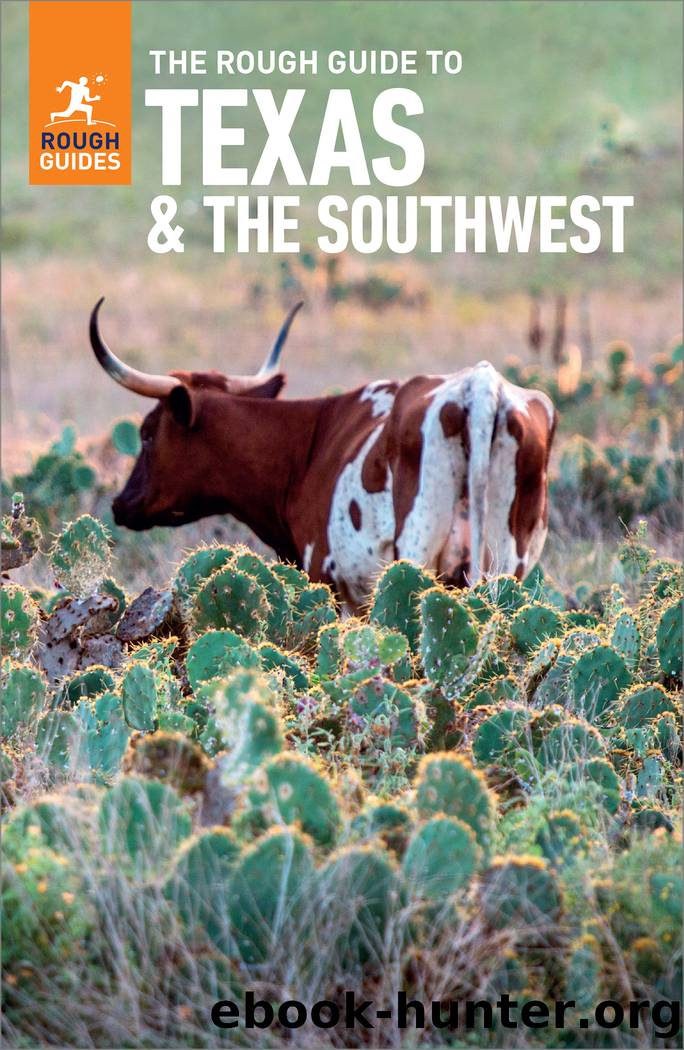The Rough Guide to Texas & the Southwest (Travel Guide with Free eBook) by Rough Guides

Author:Rough Guides
Language: eng
Format: epub
Tags: Travel, USA
Publisher: Apa Publications
Published: 2023-09-15T00:00:00+00:00
The High Road
The quickest route between Santa Fe and Taos follows US-84 as far as the Rio Grande, then follows the river northeast on Hwy-68. US-84 passes through the heartland of the northern pueblos, a cluster of tiny Tewa-speaking communities, but unless your visit coincides with a feast day, thereâs little to see.
However, the circuitous âHigh Roadâ leaves US-68/84 a dozen miles north of Santa Fe, near Nambe Pueblo. Leading high into the wooded Sangre de Cristo Mountains, it passes a number of pueblos and Hispanic villages.
Santuario de Chimayó
Daily: MayâSept 9amâ6pm; OctâApril 9amâ5pm; Mass MonâSat 11am, Sun 10.30am & noon ⢠http://holychimayo.us
The quaint mountain village of CHIMAYÃ, 25 miles north of Santa Fe where Hwy-503 meets Hwy-76, is the site of the 1816 Santuario de Chimayó. Known as the âLourdes of Americaâ for the devotion of its many pilgrims, this round-shouldered, twin-towered adobe beauty sits behind an enclosed courtyard; a pit in a side room holds the âholy dirtâ for which the site is venerated.
Accommodation and eating The High Road
Hacienda Rancho de Chimayó Hwy-98; http://ranchodechimayo.com. Immediately across from the Rancho restaurant, and run by the same management, this peaceful B&B inn offers seven appealing en-suite rooms, arranged around a shared courtyard; several have their own patio space. $
ïªRancho de Chimayó Hwy-98; http://ranchodechimayo.com. The best traditional New Mexican restaurant in the state, serving superb flautas and a mouthwatering sopaipilla, stuffed with meat and chillis, on a lovely sun-drenched outdoor patio. $$
Taos
Still home to one of the longest-established Native American populations in the USA, though transformed by becoming first a Spanish colonial outpost and more recently a hangout for bohemian artists, Hollywood exiles and New Age dropouts, TAOS (which rhymes with âmouseâ) is famous out of all proportion to its size. Not quite six thousand people live in its three component parts: Taos itself, around the plaza; sprawling Ranchos de Taos, three miles to the south; and the Indigenous community of Taos Pueblo, two miles north.
Beyond the usual unsightly highway sprawl, Taos is a delight to visit. Besides museums, galleries and stores, it still offers an unhurried pace and charm and the sense of a meeting place between Pueblo, Hispanic and American cultures. Its reputation as an artistsâ colony began at the end of the nineteenth century, and new generations of artists and writers have âdiscoveredâ Taos ever since. English novelist D.H. Lawrence visited in the 1920s, while Georgia OâKeeffe arrived soon afterwards.
Taos plaza
The old Spanish plaza at the heart of Taos is now ringed by jewellery stores, art galleries and restaurants; all conform to the predominant Pueblo motif of rounded brown adobe. Specific sights are few â a small gallery in the Fonda de Taos holds a collection of nine sexy but amateurish paintings by D.H. Lawrence (aka the âForbidden Artâ collection), and the tree-filled square itself is often animated by guitar-toting buskers â but the surrounding streets are perfect for an aimless stroll.
Governor Bent House and Museum
117 Bent St ⢠Daily: AprilâOct 9amâ5pm; NovâMarch 10amâ4pm ⢠Charge ⢠505 758 2376
Bent
Download
This site does not store any files on its server. We only index and link to content provided by other sites. Please contact the content providers to delete copyright contents if any and email us, we'll remove relevant links or contents immediately.
| General | Austin |
| Big Bend | Dallas & Fort Worth |
| Houston | San Antonio |
Giovanni's Room by James Baldwin(5898)
The Plant Paradox by Dr. Steven R. Gundry M.D(2053)
The Stranger in the Woods by Michael Finkel(1934)
Miami by Joan Didion(1885)
DK Eyewitness Top 10 Travel Guides Orlando by DK(1821)
Vacationland by John Hodgman(1781)
Trail Magic by Trevelyan Quest Edwards & Hazel Edwards(1765)
Wild: From Lost to Found on the Pacific Crest Trail by Cheryl Strayed(1750)
INTO THE WILD by Jon Krakauer(1732)
The Twilight Saga Collection by Stephenie Meyer(1729)
Nomadland by Jessica Bruder(1693)
Birds of the Pacific Northwest by Shewey John; Blount Tim;(1611)
Portland: Including the Coast, Mounts Hood and St. Helens, and the Santiam River by Paul Gerald(1586)
The Last Flight by Julie Clark(1504)
On Trails by Robert Moor(1487)
Deep South by Paul Theroux(1482)
Trees and Shrubs of the Pacific Northwest by Mark Turner(1434)
Blue Highways by William Least Heat-Moon(1385)
1,000 Places to See in the United States and Canada Before You Die (1,000 Places to See in the United States & Canada Before You) by Patricia Schultz(1303)
